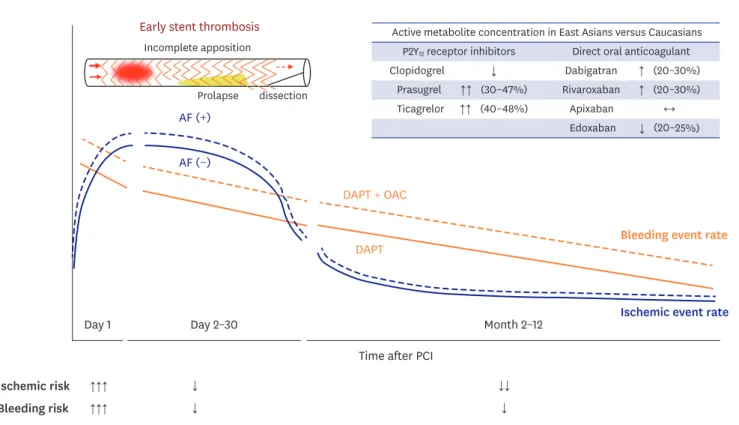423 https://e-kcj.org
Dual antiplatelet therapy (DAPT) using aspirin and P2Y
12receptor inhibitor has been proven to reduce recurrent ischemic events, such as stent thrombosis and myocardial infarction (MI), after percutaneous coronary intervention (PCI), but it is less effective for prevention of ischemic stroke and systemic embolism in patients with atrial fibrillation (AF) when compared with oral anticoagulation therapy (OAC).
1)Triple antithrombotic therapy (TAT) with OAC and DAPT has been recommended in treatment guidelines for patients with AF after PCI. However, this approach could increase the risk of excessive major bleeding. In Korea, only DAPT was prescribed in more than 90% of patients with AF after PCI during the era of vitamin K antagonist (VKA) for OAC.
2)Discrepancies between guidelines and real- world clinical practice might be associated with bleeding concerns including intracranial hemorrhage and inconvenience to use of VKA such as narrow therapeutic window, drug and dietary interactions, and intra-patient variability requiring frequent monitoring.
In this edition of the Korean Circulation Journal, Kwon et al.
3)showed the patterns of peri- procedural antithrombotic regimens in 27,594 Korean patients with AF who underwent PCI using the claims database of the Health Insurance Review and Assessment (HIRA). The patterns of peri-procedural antithrombotic regimens have changed rapidly toward more use of non-vitamin K antagonist oral anticoagulants (NOAC)-based TAT from DAPT without OAC. These change were possibly due to the introduction and insurance coverage of NOACs in Korea. NOACs reduce the risk of hemorrhagic stroke and all-cause mortality than VKA, and the benefit was more profound in Asian population than in non-Asian populations,
1)and NOACs also have pharmacologic advantages over VKA including rapid onset/offset action, fewer drug and dietary interactions, and no need for regular monitoring. When Korean clinicians decided on NOAC-based regimen, percentage of reduced-dose NOACs gradually increased from 57.5% to 81.4%. This pattern might reflect the concerns of major bleeding in using TAT with regular-dose NOACs. Except apixaban, the concentration of active metabolites of NOACs was different according to the races (Figure 1). East Asian patients had more major bleeding risks with relatively low concentrations of NOACs compared with Caucasians.
4)An interesting finding of the present study was that the proportion of ticagrelor among P2Y
12receptor inhibitors has been substantially increased. However, it is Korean Circ J. 2021 May;51(5):423-425
https://doi.org/10.4070/kcj.2021.0017 pISSN 1738-5520·eISSN 1738-5555
Editorial
Received: Jan 18, 2021 Accepted: Jan 29, 2021 Correspondence to Hyun Kuk Kim, MD, PhD
Department of Internal Medicine and Cardiovascular Center, Chosun University Hospital, University of Chosun College of Medicine, 365, Pilmun-daero, Dong-gu, Gwangju 61453, Korea.
E-mail: sale38@hanmail.net sj800919@chosun.ac.kr Copyright © 2021. The Korean Society of Cardiology
This is an Open Access article distributed under the terms of the Creative Commons Attribution Non-Commercial License (https://
creativecommons.org/licenses/by-nc/4.0) which permits unrestricted noncommercial use, distribution, and reproduction in any medium, provided the original work is properly cited.
ORCID iDs Sung Soo Kim
https://orcid.org/0000-0002-5190-227X Hyun Kuk Kim
https://orcid.org/0000-0002-4554-041X Funding
This study was supported by research funds from the Basic Science Research Program through the National Research Foundation of Korea (NRF-2018R1D1A1B07040783).
Sung Soo Kim , MD, PhD, and Hyun Kuk Kim , MD, PhD
Department of Internal Medicine and Cardiovascular Center, Chosun University Hospital, University of Chosun College of Medicine, Gwangju, Korea
Beginning the Journey to Find Optimal Antithrombotic Regimens for Korean Patients with Atrial Fibrillation after Percutaneous Coronary Intervention
►
